QUESTIONS
SECTION A (25 MARKS)
- In an experiment to determine the presence of charge on a body, a material to be tested was brought close to the cap of a positively charged electroscope. There was no divergence observed from the leaf of electroscope. State the possible reason for the observation. (1 mark)
- A cog wheel with 20 teeth is rotated with a stiff card pressing lightly against the teeth. Sound is produced when the rotating teeth strikes the card. Calculate the wavelength of sound produced if the wheel makes 20 revolutions per second. (Velocity of sound in air is 330m/s). (2 marks)
- State any two ways of in increasing the size of an image formed by a fixed pinhole camera, (2 mks)
- Figure 1 shows a symbol representing an electrical device.

Figure 1
Name the device represented by the symbol (1 mark) - A car battery is rated 40Ah and is expected to supply a constant current for 200 minutes. Determine the amount of current delivered. (2 marks)
- The figure 2 below show a soft iron plate in a solenoid and a permanent magnet suspended by a spring.
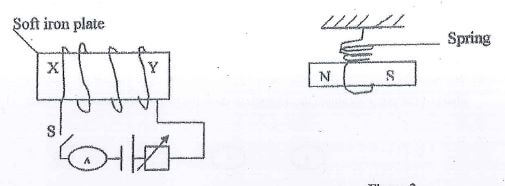
Figure 2
State with reason the behaviour of the magnet when the switch S is closed. (2 mks) - Figure 3 shows a cell of e.m.f 1.5V connected with an ammeter, a 1.52 resistor a 12 and switch. A voltmeter is connected across the cell.
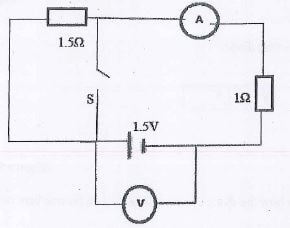
Figure 3
With the switch open, the voltmeter reads 1.25V. Given that the internal resistance of the cell is 0.50, determine the ammeter reading when switch S is closed. (3 marks) - Water waves pass a point in a swimming pool at the rate of 30 crests per 60 seconds. One of the crests was observed to take 2 seconds to travel between 2 points, 6m apart. Determine the wavelength of the water waves. (3 marks)
- The figure 4 below shows a cathode ray beam entering a magnetic field, perpendicular to the plane of the paper complete the diagram to show the path of the beam in the field. (1 mark)
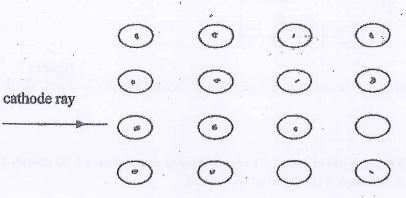
Figure 4 - The figure 5 below shows a junction diode.

Figure 5
Complete the diagram to show how the diode can be connected in a reverse bias mode. (1 mark) - An electric heater rated 240V, 3000W is to be connected to a 240V mains supply, through a 10A fuse. Determine whether the fuse is suitable or not. (3 marks)
- Two heating coils A and B connected in parallel in a circuit produces power of 36W and 54W respectively. Calculate the ratio of their resistance. (2 marks)
- The figure 6 below show a conductor carrying electric current place between two magnetic poles.
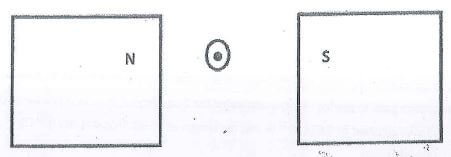
Figure 6
Complete the diagram by sketching the magnetic field and also show the direction of the force on the conductor. (2 marks)
SECTION B (55 MARKS)
-
- Figure 7 shows parts of a simple x-ray tube..
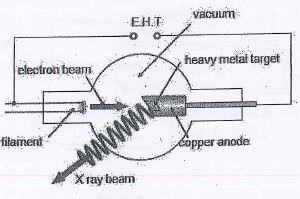
Figure 7- Explain how the beam of x-ray is produced. (3 marks)
- State how the current and voltage from the Extra High Tension (E.H.T) source can be used to:
- Increase the intensity of x-ray beam produced. (1 mark)
- Decrease the strength of the X-ray beam produced (1 mark)
- Tungsten is an example of element used as metal target. State the property that enables it to be used as a target. (1 marks)
- In a certain X ray tube, the electrons are accelerated by a p.d of 12000 V. Assuming that all the energy goes to produce x rays, determine the frequency of the x rays produced (take planks constant h=6.62x10-34Js, and the charge of an electron e=1.6x10-19C) (3marks)
- Figure 7 shows parts of a simple x-ray tube..
-
- The figure 8 below shows a diagram of a Geiger Muller tube connected to a power supply and a pulse counter.
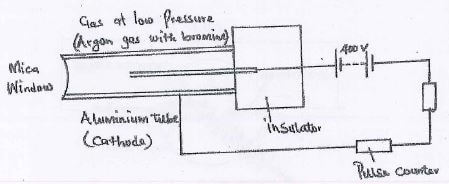
Figure 8- State why should the argon gas be at low pressure. (1mark)
- State the purpose of the bromine gas in the tube. (1mark)
- Suggest one way of increasing the sensitivity of the tube (1 mark)
- Find the value of a and b in the following equation. (2mark)

a .................................. b ..................................
- The figure 9 below shows a PN junction diode used in a rectifier.

Figure 9- Describe how the rectification is achieved (3 marks)
- In the space provided below, sketch the output signal displayed on the CRO during the rectification process. (1 mark)
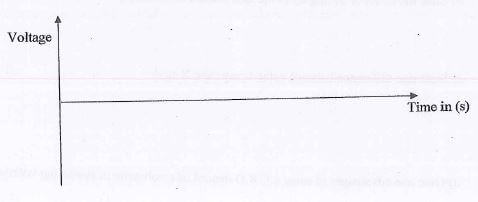
- The figure 8 below shows a diagram of a Geiger Muller tube connected to a power supply and a pulse counter.
- The figure 10 below shows a cathode ray tube
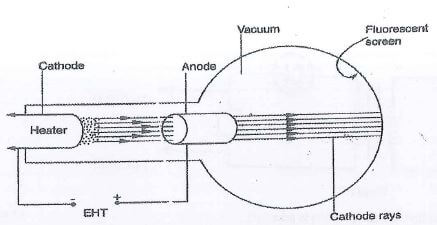
Figure 10- State how the intensity of the fluorescence on the screen can be increased. (1 mark)
- State the effect of having air in the tube instead of a vacuum (2 mark)
- State one difference between cathode rays and X-rays (1 mark)
- Give one advantages of using a C.R.O instead of a voltmeter in measuring voltages (1 mark)
- The figure 11 below shows an a.c. voltage. If the Y-gain control reads 10V/cm and the time base reads 5 milliseconds/cm
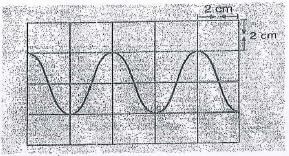
Figure 11
Calculate:- The frequency of the alternating voltage (2 marks)
- Peak to peak voltage of the alternating voltage (2 marks)
-
-
- It is observed that when ultra-violet radiation is directed onto a clean zinc plate connected to the cap of a negatively charged leaf electroscope, the leaf falls. Explain this observation (2 marks)
- Explain why the leaf of the electroscope does not fall when infra-red radiation is directed onto the zinc plate (1 mark)
- State the effect on the electrons emitted by the photoelectric effect when:
- The intensity of incident radiation is increased (1 mark)
- The frequency of the incident radiation is increased (1 mark)
- Light of wavelength 4.3 x 10-7m is incident on two different metal surfaces, nickel and potassium. (Take speed of light as 3.0 x 108 ms-1 and planks constant has 6.63 x 10-34Js).
- Determine the energy of the incident radiation. (2 marks)
- If the work function of nickel is 8.0 x 10-19J and that of potassium is 3.68 x 10-19J, state with a reason from which of the two metals the given light will eject electrons. (2 marks)
- Determine the velocity of the emitted electrons from the metal surface in b(ii). (Take the mass of an electron as 9.1 x 10-31 kg). (3 marks)
-
-
-
- State the meaning of the term critical angle as applied in refraction of light. (1 mark)
- The figure 12 shows a ray of light incident on a glass-air interface.
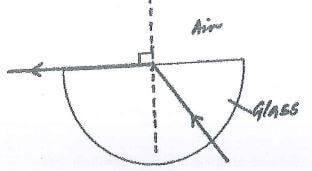
Figure 12- Show on the diagram the critical angle, c. (1 mark)
- Given that the refractive index of the glass is ans, and that the critical angle c=42°, determine the value of is aηg (3 marks)
- The figure 13 shows an experimental set up consisting of a mounted convex lens L, cardboard screen with cross-wires at the centre, a plane mirror, a metre rule and a candle.
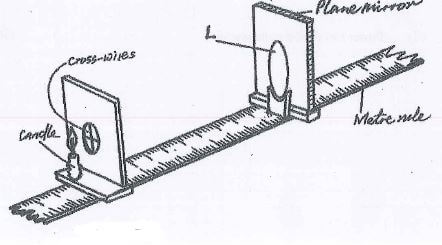
Figure 13
Describe how the set-up may be used to determine the focal length, f, of the lens. (4 marks)
-
-
- State one advantage of high voltage transmission. (1mark)
- A generator produces 150kw at a voltage of 5kV. The voltage is stepped up to 60kV and transmitted through cables of resistance 159 to a step-down transformer in a substation. If both transformers are 80% efficient, calculate the:
- Current through the transmission cables. (3marks)
- Power lost during transmission. (3marks)
MARKING SCHEME
SECTION A (25 MARKS)
- In an experiment to determine the presence of charge on a body, a material to be tested was brought close to the cap of a positively charged electroscope. There was no divergence observed from the leaf of electroscope. State the possible reason for the observation. (1 mark)
the material was an insular / had no change on its surfacae / neutral material - A cog wheel with 20 teeth is rotated with a stiff card pressing lightly against the teeth. Sound is produced when the rotating teeth strikes the card. Calculate the wavelength of sound produced if the wheel makes 20 revolutions per second. (Velocity of sound in air is 330m/s). (2 marks)
f = No. of teeth x revolutions
= 20 x 20 = 400Hz
λ = v/f = 330/400 = 0.825 m - State any two ways of in increasing the size of an image formed by a fixed pinhole camera, (2 mks)
reducing the distance between the object and the pinhole
increasing the distance between screen and pinhole - Figure 1 shows a symbol representing an electrical device.

Figure 1
Name the device represented by the symbol (1 mark)
variable resistor / rheostat / potential divider / potentiometer - A car battery is rated 40Ah and is expected to supply a constant current for 200 minutes. Determine the amount of current delivered. (2 marks)
I = Q/t = 40/200 x 60
= 12 A - The figure 2 below show a soft iron plate in a solenoid and a permanent magnet suspended by a spring.

Figure 2
State with reason the behaviour of the magnet when the switch S is closed. (2 mks)
magnet moves away from the solenoid / it is repelled End Y acquires a N-pole whichrepels the N-pole of the permanent magnet - Figure 3 shows a cell of e.m.f 1.5V connected with an ammeter, a 1.52 resistor a 12 and switch. A voltmeter is connected across the cell.

Figure 3
With the switch open closed, the voltmeter reads 1.25V. Given that the internal resistance of the cell is 0.50, determine the ammeter reading when switch S is closed. (3 marks)
1.5Ω resistor is short circuited
E = v + Ir
1.5 = 1.25 + 0.5r
I = 0.5A - Water waves pass a point in a swimming pool at the rate of 30 crests per 60 seconds. One of the crests was observed to take 2 seconds to travel between 2 points, 6m apart. Determine the wavelength of the water waves. (3 marks)
v = 6/2 = 3m/s
f = 30/60 = 0.5Hz
λ = v/f = 3/0.5 = 6m - The figure 4 below shows a cathode ray beam entering a magnetic field, perpendicular to the plane of the paper complete the diagram to show the path of the beam in the field. (1 mark)

Figure 4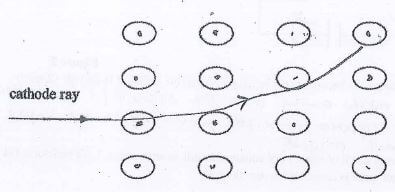
- The figure 5 below shows a junction diode.

Figure 5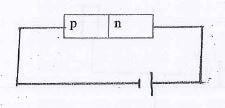
Complete the diagram to show how the diode can be connected in a reverse bias mode. (1 mark) - An electric heater rated 240V, 3000W is to be connected to a 240V mains supply, through a 10A fuse. Determine whether the fuse is suitable or not. (3 marks)
I = P/v = 3000/240 = 12.5A
The fuse is not suitable as it allows a lower current / lower rating - Two heating coils A and B connected in parallel in a circuit produces power of 36W and 54W respectively. Calculate the ratio of their resistance. (2 marks)
PA = 36W
PB = 54W
P = V2 => V2 = PR
R
But V is the same
PARA = PBRB
36RA = 54RB
RA = 54 = 3
RB 36 2
RA: RB = 3:2
RB:RA = 2:3 - The figure 6 below show a conductor carrying electric current place between two magnetic poles.

Figure 6
Complete the diagram by sketching the magnetic field and also show the direction of the force on the conductor. (2 marks)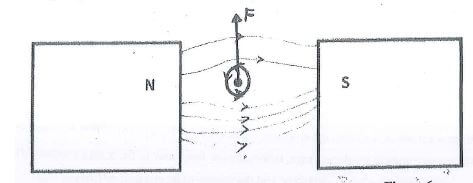
SECTION B (55 MARKS)
-
- Figure 7 shows parts of a simple x-ray tube..

Figure 7- Explain how the beam of x-ray is produced. (3 marks)
stream of that moving es produced from filament by thermionic emissions are accelerated to anode. They are suddenly stopped by a metal target producing x-rays - State how the current and voltage from the Extra High Tension (E.H.T) source can be used to:
- Increase the intensity of x-ray beam produced. (1 mark)
increasing current through filament - Decrease the strength of the X-ray beam produced (1 mark)
decreasing accelarating potential/voltage
- Increase the intensity of x-ray beam produced. (1 mark)
- Tungsten is an example of element used as metal target. State the property that enables it to be used as a target. (1 marks)
it has a high melting point
- Explain how the beam of x-ray is produced. (3 marks)
- In a certain X ray tube, the electrons are accelerated by a p.d of 12000 V. Assuming that all the energy goes to produce x rays, determine the frequency of the x rays produced (take planks constant h=6.62x10-34Js, and the charge of an electron e=1.6x10-19C) (3marks)
e.v = hf
1.6 x 10-19 x 12000 = 6.62 x 10-34f
f = 2.9 x 1018Hz
- Figure 7 shows parts of a simple x-ray tube..
-
- The figure 8 below shows a diagram of a Geiger Muller tube connected to a power supply and a pulse counter.

Figure 8- State why should the argon gas be at low pressure. (1mark)
to initiate discharge. It allows for secondary ionisation creating an avalanche of electrons - State the purpose of the bromine gas in the tube. (1mark)
quenching agent - absorbs energy of positive ions before they cause secondary electron emission - Suggest one way of increasing the sensitivity of the tube (1 mark)
amplifying the covalent/coolant - Find the value of a and b in the following equation. (2mark)

a ....226.... b ......88......
- State why should the argon gas be at low pressure. (1mark)
- The figure 9 below shows a PN junction diode used in a rectifier.

Figure 9- Describe how the rectification is achieved (3 marks)
during the 1st cycle the diode is foward based so it conducts. Coolant flows through the resistor. During the 2nd cycle the diode is reverse based so it does not conduct. No current passes through resistor. The process keeps repeating itself. - In the space provided below, sketch the output signal displayed on the CRO during the rectification process. (1 mark)

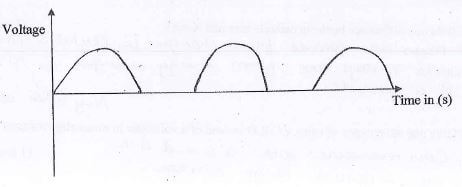
- Describe how the rectification is achieved (3 marks)
- The figure 8 below shows a diagram of a Geiger Muller tube connected to a power supply and a pulse counter.
- The figure 10 below shows a cathode ray tube

Figure 10- State how the intensity of the fluorescence on the screen can be increased. (1 mark)
increasing the p.d. of the cathode
making the grid less negative - State the effect of having air in the tube instead of a vacuum (2 mark)
ionization
there will be collisions between the air particles and electrons in motion reducing the energy of the electrons - State one difference between cathode rays and X-rays (1 mark)
x-rays are formed from changes in electrons structure while r-rays are from energy changes in nucleus of a nuclide
any other correct - Give one advantages of using a C.R.O instead of a voltmeter in measuring voltages (1 mark)
can measure both a.c and d.c
can measure large voltage - The figure 11 below shows an a.c. voltage. If the Y-gain control reads 10V/cm and the time base reads 5 milliseconds/cm

Figure 11
Calculate:- The frequency of the alternating voltage (2 marks)
T = 4 x 5 = 20 ms
= 20 x 10-3
f = 1/T = 1/20x 10-3
= 50Hz - Peak to peak voltage of the alternating voltage (2 marks)
v = 4 x 10
= 40v
- The frequency of the alternating voltage (2 marks)
- State how the intensity of the fluorescence on the screen can be increased. (1 mark)
-
-
- It is observed that when ultra-violet radiation is directed onto a clean zinc plate connected to the cap of a negatively charged leaf electroscope, the leaf falls. Explain this observation (2 marks)
elections are didslodged from the zinc metal by U-V radiations. The electrons emitted are repelled by the negative changes leaving the plate positively changed. electrons from the leaf move to the cap and leaf - Explain why the leaf of the electroscope does not fall when infra-red radiation is directed onto the zinc plate (1 mark)
the enrgy of IR radiation is lower than the work function of the zinc plate/metal
- It is observed that when ultra-violet radiation is directed onto a clean zinc plate connected to the cap of a negatively charged leaf electroscope, the leaf falls. Explain this observation (2 marks)
- State the effect on the electrons emitted by the photoelectric effect when:
- The intensity of incident radiation is increased (1 mark)
increases the no. of photo electrons thus increasing the photocurrent - The frequency of the incident radiation is increased (1 mark)
speed of electrons increases
- The intensity of incident radiation is increased (1 mark)
- Light of wavelength 4.3 x 10-7m is incident on two different metal surfaces, nickel and potassium. (Take speed of light as 3.0 x 108 ms-1 and planks constant has 6.63 x 10-34Js).
- Determine the energy of the incident radiation. (2 marks)
E = hc = 6.63 x 10-34 x 3 x 108
λ 4.3 x 10-7
= 4.626 x 10-19J - If the work function of nickel is 8.0 x 10-19J and that of potassium is 3.68 x 10-19J, state with a reason from which of the two metals the given light will eject electrons. (2 marks)
potassium
energy of radiation is greator than its work function - Determine the velocity of the emitted electrons from the metal surface in b(ii). (Take the mass of an electron as 9.1 x 10-31 kg). (3 marks)
E = W0 + 1/2mv2
4.626 x 10-19 = 3.68 x 10-19 + (1/2 x 9.1 x 10-31)v2
v = 4.56 x 105 m/s
- Determine the energy of the incident radiation. (2 marks)
-
-
-
- State the meaning of the term critical angle as applied in refraction of light. (1 mark)
this is the angle of incidence in the optically dense medium whose angle of refraction in the less optically dense medium is 90º - The figure 12 shows a ray of light incident on a glass-air interface.

Figure 12- Show on the diagram the critical angle, c. (1 mark)
- Given that the refractive index of the glass is ans, and that the critical angle c=42°, determine the value of is aηg (3 marks)
aηg = 1/sinºC = 1/sin43º = 1.4945
- State the meaning of the term critical angle as applied in refraction of light. (1 mark)
- The figure 13 shows an experimental set up consisting of a mounted convex lens L, cardboard screen with cross-wires at the centre, a plane mirror, a metre rule and a candle.

Figure 13
Describe how the set-up may be used to determine the focal length, f, of the lens. (4 marks)- Move the cardboard with a crosswire along the metre rule until a sharp image of the crossswire is formed alongside the object crosswire
- Measure the distance between the lens and the cardboard. this equal to the facical length of the lens
- Repeat procedures and find the average value of f.
-
-
- State one advantage of high voltage transmission. (1mark)
the current is low and therefore energy loss is reduced - A generator produces 150kw at a voltage of 5kV. The voltage is stepped up to 60kV and transmitted through cables of resistance 159 to a step-down transformer in a substation. If both transformers are 80% efficient, calculate the:
- Current through the transmission cables. (3marks)
80/100 x 150000 = 120000w
I = P/v = 120000 = 2A
60000 - Power lost during transmission. (3marks)
power lost = I2R
= 22 x 15
= 60W
- Current through the transmission cables. (3marks)
- State one advantage of high voltage transmission. (1mark)
Download Physics Paper 2 Questions and Answers - Mangu High School Mock Exams 2022.
Tap Here to Download for 50/-
Get on WhatsApp for 50/-
Why download?
- ✔ To read offline at any time.
- ✔ To Print at your convenience
- ✔ Share Easily with Friends / Students
